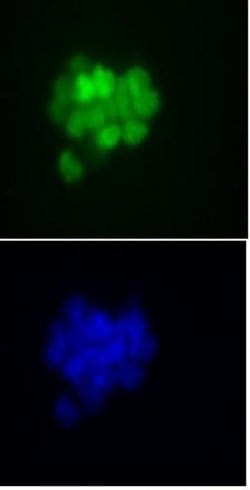Promotional price valid on web orders only. Your contract pricing may differ. Interested in signing up for a dedicated account number?
Learn More
Learn More
Nanog Monoclonal Antibody (2E6E1), Active Motif™


Rat Monoclonal Antibody
$135.30 - $405.90
Specifications
| Antigen | Nanog |
|---|---|
| Clone | 2E6E1 |
| Concentration | 1 mg/mL |
| Applications | Immunocytochemistry, Immunofluorescence, Western Blot |
| Classification | Monoclonal |
| Catalog Number | Mfr. No. | Quantity | Price | Quantity & Availability | |||||
|---|---|---|---|---|---|---|---|---|---|
| Catalog Number | Mfr. No. | Quantity | Price | Quantity & Availability | |||||
50-199-3565
 
|
Active Motif
61628 |
10 μg |
Each for $135.30
|
|
|||||
50-199-3564
 
|
Active Motif
61627 |
100 μg |
Each for $405.90
|
|
|||||
Description
NANOG (Nanog homeobox) is a divergent homeodomain protein that directs pluripotency and differentiation of undifferentiated embryonic stem cells. NANOG mRNA is present in pluripotent mouse and human cell lines, and absent from differentiated cells. Human NANOG protein shares 52% overall amino acid identity with the mouse protein, and 85% identity in the homeodomain. Human NANOG maps to gene locus 12p13.31, while the mouse NANOG maps to gene loci 6 F2. Murine embryonic NANOG expression is detected in the inner cell mass of the blastocyst. Research studies have shown that high levels of human NANOG expression in the undifferentiated N-Tera embryonal carcinoma cell line. Further, NANOG is a transcription regulator involved in inner cell mass and embryonic stem (ES) cells proliferation and self-renewal. The role of NANOG in embryonic development suggested that it might be useful in the creation of stem cells that might be useful in cell replacement therapies in the treatment of several degenerative diseases. Artificial stem cells, termed induced pluripotent stem (iPS) cells, can be created by expressing POU5F1 (also known as Oct-4), another germline-specific transcription factor, and the transcription factors Sox2, Klf4 and Lin28 along with c-Myc in mouse fibroblasts. Experiments have demonstrated that iPS cells could be generated using expression plasmids expressing NANOG, Sox2, KlfF4 and c-Myc, eliminating the need for virus introduction, thereby addressing a safety concern for potential use of iPS cells in regenerative medicine. When overexpressed, NANOG promotes cells to enter into S phase and proliferation. Diseases associated with dysfunction in the NANOG protein include tetracarcinoma and germ cell/embryonal cancer.Specifications
| Nanog | |
| 1 mg/mL | |
| Monoclonal | |
| Liquid | |
| RUO | |
| PBS with 30% glycerol and 0.035% sodium azide; pH 7.5 | |
| 2410002E02Rik; early embryo specific expression NK family; Early embryo specific expression NK-type homeobox protein; Ecat4; Enk; ES cell-associated protein 4; FLJ12581; HGNC:20857; hNanog; Homeobox protein NANOG; Homeobox transcription factor Nanog; homeobox transcription factor Nanog-delta 48; homeodomain transcription factor Nanog; NANOG; Nanog homeobox; Nanog homeodomain transcription factor | |
| NANOG | |
| IgG2a | |
| Protein G | |
| Antibody |
| 2E6E1 | |
| Immunocytochemistry, Immunofluorescence, Western Blot | |
| Unconjugated | |
| Rat | |
| Mouse | |
| Q80Z64 | |
| 71950 | |
| This antibody was raised against a peptide comprising amino acids 2-25 of mouse Nanog. | |
| Primary | |
| -20°C, Avoid Freeze/Thaw Cycles | |
| NANOG |
Spot an opportunity for improvement?Share a Content Correction
Product Content Correction
The Fisher Scientific Encompass Program offers items which are not part of our distribution portfolio. These products typically do not have pictures or detailed descriptions. However, we are committed to improving your shopping experience. Please use the form below to provide feedback related to the content on this product.
Product Title

